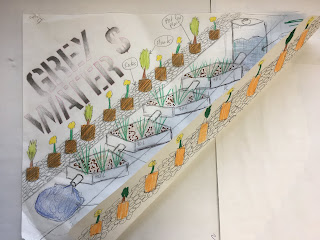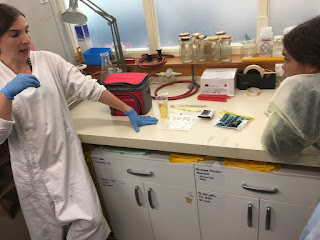Designing a grey water system as a Whanganui based school science experiment

Grey water is very variable in composition. It can contain soap and detergents and bits of dead skin, hair and lint that get washed off our bodies when we shower. It should be low in nitrogen compounds as human urea is flushed separately down the toilet. Phosphorus, another important element for plant growth, is found in laundry detergent and although it is low toxicity it can lead to nutrient pollution and the growth of algal blooms when waste water is released into the environment. Total coliforms/E.coli and other microbes associated with the mouth, nose and throat of humans have been also found in grey water. In a school we will always be limited by resources as to what we can measure but total coliforms and E.coli that indicates faecal contamination will be measured by us as part of this study
We built a prototype grey water system in our Science lab out of three discarded 10L paint buckets connected by alkathene piping to drip the water from stage to stage. The base of each bucket was lined with shell rock and a design was made so that the lines could be decoupled and unblocked easily if they were filled with fine sediment. A 20 litre header tank was used to store shower water which was classified as 'grey' or 'eco-friendly' depending on the source of the shampoo and soap. A water marginal grass was planted in compost on top of the rock beds since we knew it would survive having 'wet feet'. Compost was used as a growing medium because it would support plant growth and mimic the soil of a wetland area. We decided not to use the plants supplied by ESR/PTC as they were unknown quantities and they were needed for another experiment (see next post). Tannins released from the compost, we would find out later, turned the filtered water the colour of whisky!
 Although we are now geared up to measure a raft of water quality indicators to determine the performance of our grey water system when we build it on a bigger scale, when we built this prototype system we wanted to see if any cleaning as such was being done and whether the grass plants would survive a diet of grey water for 10 weeks.
Although we are now geared up to measure a raft of water quality indicators to determine the performance of our grey water system when we build it on a bigger scale, when we built this prototype system we wanted to see if any cleaning as such was being done and whether the grass plants would survive a diet of grey water for 10 weeks.
The most obvious thing we learned was how the clarity of the water improved as it was filtered through the soil. Grey water is also chemically basic with a pH of 8 or above due to the presence of soap. We found out that the system neutralised the soap basicity lowering the pH to that of the local tap water (pH 7.5). The grass plants grew strongly throughout and survived the 10 week trial.





Comments
Post a Comment